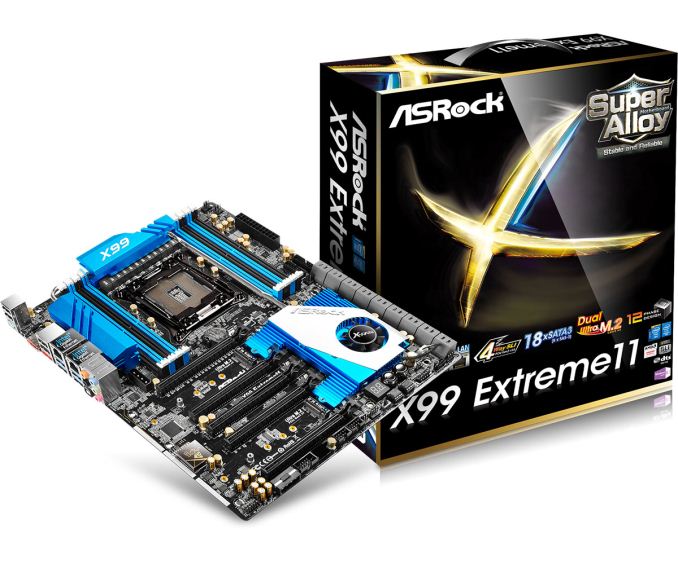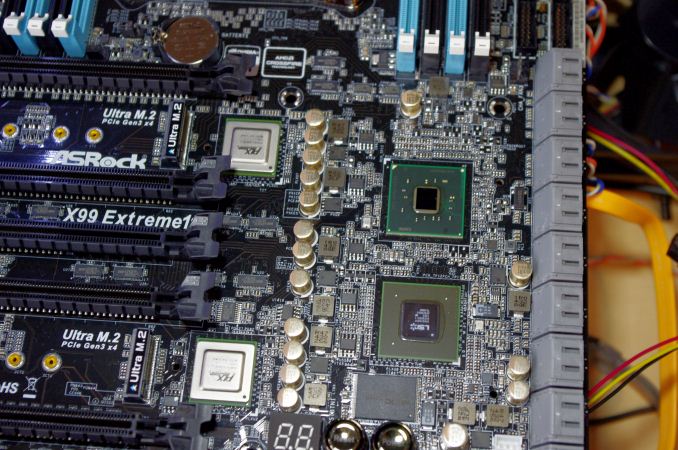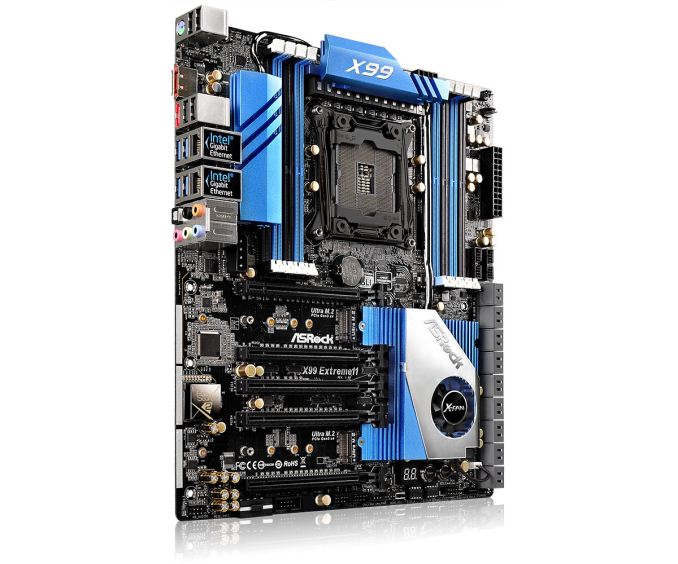The ASRock X99 Extreme11 Review: Eighteen SATA Ports with Haswell-E
by Ian Cutress on March 11, 2015 8:00 AM EST- Posted in
- Motherboards
- Storage
- ASRock
- X99
- LGA2011-3
The ASRock X99 Extreme11 Conclusion
There are particular areas of each electronics market that the general consumer doesn't see or might have difficulty understanding. If a general consumer is concerned primarily about cost, then seeing a market where money-is-no-object offers a strange perspective. Ultimately, the ASRock X99 Extreme11 is in one of these brackets. Most home users would agree that $600+ for a motherboard feels insane, but for the storage and compute markets to which it is focused, $600 can be a drop in the ocean of total system cost. It may even save a few $$$ if it has the required features already onboard.
The reason for the cost of the X99 Extreme11 stems from two PLX8747 PCIe 3.0 switches providing x16/x16/x16/x16 for four-way PCIe coprocessor action as well as an LSI 3008 SAS/SATA controller giving eight more storage ports. These eight ports combine with the ten from the chipset for a total of eighteen.
In the hierarchy of reasons to buy a motherboard, having a particular functionality rates high and it is the functionality that will cause users to buy the Extreme11, similar to the X99 WS-E/10G we reviewed previously. Alongside the to-buy features, the motherboard also comes with dual Intel network ports (I218-V and I211-AT), support for Intel Xeons and 128GB of RDIMMs and a boosted Realtek ALC1150 audio solution in the form of Purity Sound 2.
A key metric in our tests for such a board is power consumption, and given the extra components it perhaps comes as no surprise that under load the Extreme11 draws 244W at CPU load and comes in as nearly the most power hungry out of the X99 boards we have tested. The extra components pushes POST times nearer 25 seconds also. One surprising outcome was the PCH USB 3.0 speed, coming top in our test.
While the Extreme11 is not necessarily bought for performance, the base BIOS we tested with implemented a form of multi-core turbo, giving it high marks across almost all of our CPU suite. Overclocking performance on our mediocre CPU matched that of other X99 motherboards, with the range of automatic options providing suitable feedback to place a manual set of parameters.
In the past, I have always said that the first thing users consider when purchasing a motherboard is if it has a certain feature they need. (Next in the order of narrowing down the options, assuming no prior experience with a brand, is usually price, then looks, then performance, extras and support.) The ASRock X99 Extreme11 sits in that niche for users who want Haswell-E or Xeon E5 v3 as well as storage and multiple PCIe coprocessors - a niche with only few motherboardsin the self-build community, making the Extreme11 a straightforward option.













58 Comments
View All Comments
lordken - Friday, April 3, 2015 - link
Rather you should apology for being lazy. abufrejoval did run some math for you, so its pretty clear that all 18x ports wont deliver full bandwidth. If you need to run 18x SSD at full speed then you probably need server board or something.If you want to troll go elsewhere.
petar_b - Friday, January 29, 2016 - link
abufrejoval is not theoretical - 1 SSD on PCH can do 400Mb/s, but 4 SSDs simultaneously can give less 100MB/s transfer each. Now move that on SAS controller and each SSD gives 400MB/s.Once you start using SSDs on SAS - you will never go back to PCH.
I posted article a year ago on the web showing differences I have measured with crystal benchmark - values are shocking... measurements were based on ASRock X79 Extreme11, same SAS controller just CPU and RAM bit slower.
wyewye - Friday, March 13, 2015 - link
Good point duploxxx.I haven't seen a professionally done review on this site for quite a while.
petar_b - Friday, January 29, 2016 - link
Motherboard has nothing to do with gaming, go for ROG if you wish gaming. Business use, rendering, 3D where storage needs to be fast and has to be SAS.We are using older generation of the board X79 with PLX and SAS controller. There are no words nor space here to explain you what performance increase we we hook up 8 SSDs (960G) on SAS instead of Intel...
It's perfect for virtualization on or cloud realization - example: 128GB RAM + 6T SSDs can accomodate more than 20 vmware images, each with 4GB ram, running perfectly on Xeon.
@dicobalt - keeping porn ? it's so sad ppl think no further than gaming and watching tv. go buy book and learn something... mathlab, 3d studio and earn money. actually get a tv and watch porn there.
3DoubleD - Wednesday, March 11, 2015 - link
Thanks for the review! This board is incredible. I run a storage server with a software raid (Unraid) and this board alone would handle all of my SATA port needs without the need for any PCIe SATA cards. The only issue is the price though. For $600 I could easily buy a $150 Z97 motherboard with 8 SATA ports and two PCIe 8x slots, buy two $150 PCIe 2.0 8x cards (each with 8 SATAIII ports), and I'd still have money left over (probably put it towards a better case!). Also, that's not counting the significant difference in CPU and DDR4 costs.Clearly this motherboard is meant for a use case beyond a simple storage server (so many PCIe 8x slots!), so I can't say they missed their intended mark. However, I really wish they could attempt something like this on the Z97 platform, more than 10 SATA ports but with no more than two (or three) PCIe 8x slots (even if some of them are 4x). Aim for a price below $250.
I can't pretend it would be a big seller, but I know I'd buy one!
WithoutWeakness - Thursday, March 12, 2015 - link
ASRock has the Z87 Extreme11 with 22 SATA III ports (6 from chipset, 16 from LSI controller) along with 4-way SLI support (x8,x8,x8,x8) and a pair of Thunderbolt 2 ports. I'm not sure how feasible it is to plan on using all of those with only 16 PCIe 3.0 lanes from the socket 1150 CPU but it sounds like everything you're asking for. Unfortunately it came in over $500, double your asking price.I think you'll be hard pressed to get what you're looking for at that $250 mark, especially on a Z97 board. Socket 1150 CPUs only have 16 lanes and every manufacturer who is willing to put an 8+ port RAID controller on board will also want a PLX PCIe bridge chip to avoid choking other PCIe devices (GPU's, M.2 drives, etc). The RAID chip alone would bring a $100 motherboard into the $200+ range and adding the PLX chip would likely bring it to $250+. At that point every manufacturer is going to look at a board with 14+ SATA ports, a PLX chip, and a Z97 chipset and say "lets sell it to gamers" and slap on some monster VRM setup, additional USB 3.0 ports, 4 PCIe 16x lanes, bake in some margin, and sell it for $400+.
3DoubleD - Friday, March 13, 2015 - link
Makes sense. Thanks for the suggestion, I'll look into it. Not sure why I've never come across this board, doesn't seem like it is sold at any of the common outlets I shop at (Newegg.ca, ect.). Still, going the add-in SATA cards seems to be the more economical way.wintermute000 - Sunday, March 15, 2015 - link
You wouldn't have ECC with Z97.Maybe unraid is better than ZFS/BTRFS but I still wouldn't roll with that much storage on a software solution (vs HW RAID) without ECC.
Vorl - Wednesday, March 11, 2015 - link
This is such a strange board. with 18 SATA connections, the first thing everyone will think is "storage server". if all 18 ports were handled with the same high end RAID controller then the $600 price tag would make sense. As it is, this system is just a confused jumble of parts slapped together.Who needs 4 PCIE x16 slots on a storage server? That is an expense for no reason.
Who needs 18 SATA connections that are all mixed around on different controllers that can't all be hardware raided together? Sure, you can run software raid, but for $600 you can buy a nice raid card, and sas to sata breakout cards and cables, and still be ahead due to full hardware performance with cache.
Also, for a server, why would they not have the IGP port? I may be missing something, but I thought they CPU has integrated graphics.
Just not an awesome setup from what I can tell.
So.. why bother having all those sata ports if they aren't all tied to RAID?
They add an LSI controller, and that isn't even what handles RAID on the system.
1nf1d3l - Wednesday, March 11, 2015 - link
LGA2011 processors do not have integrated graphics.